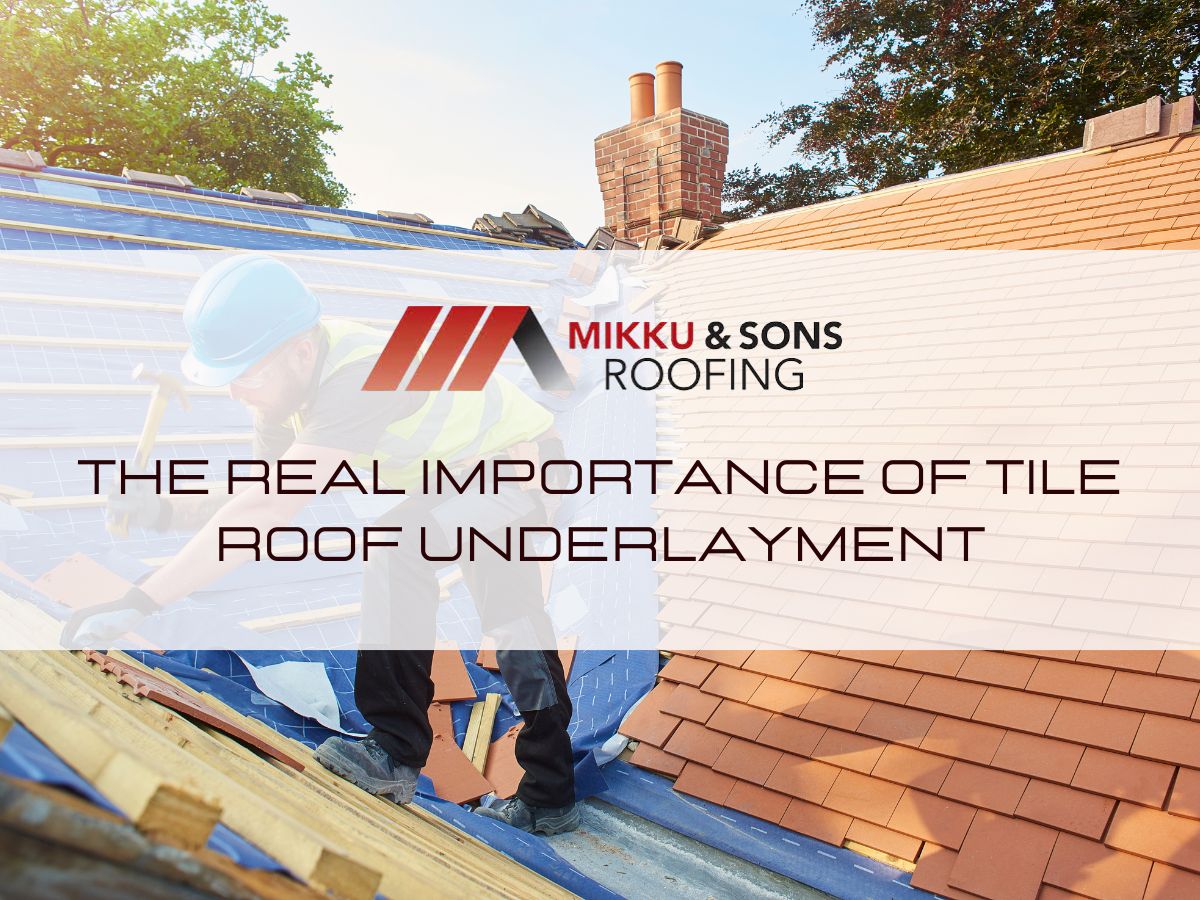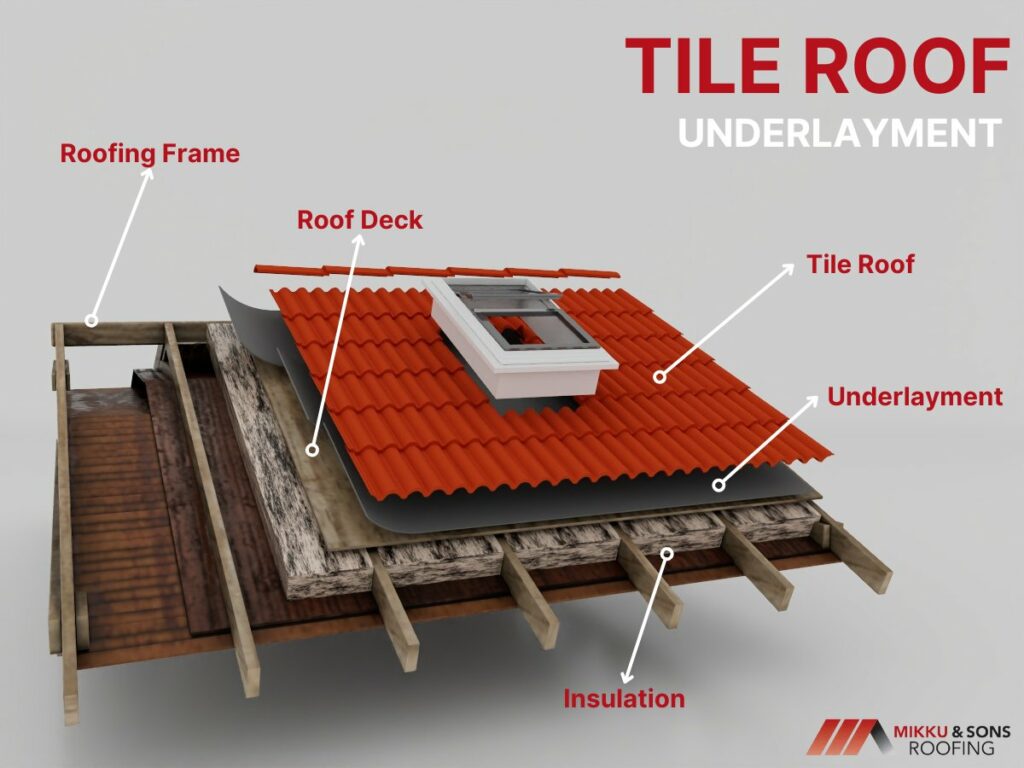

When it comes to roofing, the spotlight often shines on the tiles themselves, but the unsung hero lurking beneath is the underlayment. This critical layer acts as a protective barrier, safeguarding your home from moisture, temperature fluctuations, and potential leaks.
Often overlooked, tile roof underlayment plays a vital role in enhancing the longevity and performance of your roof. By understanding its significance, homeowners can make informed decisions that not only protect their investment but also ensure peace of mind.

Tile roof underlayment is a protective layer installed beneath roof tiles to shield your home from moisture, leaks, and temperature fluctuations. Acting as a secondary barrier, it prevents water from seeping into your roofing structure when tiles are displaced or damaged.
Underlayment adds durability and protection, ensuring your roof remains effective for years. Without a reliable underlayment, your roof is vulnerable to leaks and structural damage. It also enhances energy efficiency by providing extra insulation.
Common options include felt, synthetic, and rubberized asphalt underlayments. Choosing the right type depends on your climate and roof design. Always consult a professional for the best choice.
Tile roofs are a popular choice for their durability, aesthetic appeal, and energy efficiency. However, beneath those beautiful tiles lies a critical component that ensures the roof performs its job effectively: the underlayment. Below are five key functions of tile roof underlayment:
1. Acts as a Secondary Barrier Against Water
The primary role of tile roof underlayment is to serve as a backup layer of waterproofing. While tiles are designed to repel water, wind-driven rain or improperly sealed tiles can allow moisture to seep through. The underlayment ensures that any water that gets past the tiles doesn’t reach the roof deck, preventing water damage, leaks, and mold growth.
2. Protects the Roof Deck from Damage
The roof deck, typically made of wood or composite materials, is highly vulnerable to moisture, heat, and other environmental factors. The underlayment acts as a protective shield between the tiles and the deck. By creating a barrier, it prevents the roof deck from deteriorating prematurely due to water, heat, or UV exposure, ultimately extending the lifespan of the roof.
3. Enhances Energy Efficiency
Modern underlayment materials are often designed to provide thermal insulation. This helps regulate the temperature inside the home by reflecting or reducing heat transfer through the roof. By minimizing heat absorption, the underlayment can improve energy efficiency, lower cooling costs, and create a more comfortable indoor environment.
4. Provides Additional Wind Resistance
In regions prone to high winds, tile roofs can experience uplift pressure that may cause tiles to dislodge or break. The underlayment helps secure the roof system by providing an added layer of stability.
It prevents wind-driven rain or debris from penetrating the roof and ensures the structure holds up during severe weather conditions. Some advanced underlayments are even designed to adhere more tightly to the roof deck for enhanced wind resistance.
5. Improves Tile Installation and Performance
Tile roof underlayment plays a crucial role during installation. It creates a smooth and even surface for laying the tiles, ensuring proper alignment and stability. The underlayment can absorb minor imperfections or unevenness in the roof deck, which improves the overall performance of the tile roof system. It also provides a safe walking surface for installers, reducing the risk of tile breakage during the process.
Roof underlayment may not be the first thing you think about when considering your roof, but its quality can make a world of difference. It acts as a hidden layer of protection that supports your roof's performance and longevity.
High-quality underlayment offers more than just a safety net—it provides practical benefits that impact your home’s durability, energy efficiency, and costs over time. Below, we break down the key advantages of investing in premium underlayment.
Increased Lifespan of the Roof
One of the most significant benefits of high-quality underlayment is its contribution to the lifespan of your roof. Roof tiles or shingles are the first line of defense against the elements, but they can become worn or damaged over time.
Underlayment acts as a second shield, preventing moisture, wind, and debris from compromising the integrity of your roof. By providing this extra layer of protection, high-quality underlayment helps reduce wear and tear on the visible components of your roof.
This means fewer repairs, less frequent replacements, and a roof that lasts longer overall. For homeowners looking to maximize their investment, quality underlayment is a must.
Enhanced Energy Efficiency
High-quality underlayment also plays a role in improving your home’s energy efficiency. Its insulating properties help regulate indoor temperatures by minimizing heat transfer through the roof. This is especially important in extreme climates where roofs are exposed to intense sunlight or freezing temperatures.
With better temperature regulation, your HVAC system doesn’t have to work as hard to maintain a comfortable environment. The result is lower energy consumption and reduced utility bills. If you’re aiming for a more energy-efficient home, upgrading your underlayment is a smart move that delivers long-term benefits.
Cost Savings
While high-quality underlayment may come with a higher upfront cost, it offers substantial savings in the long run. By preventing leaks, reducing energy expenses, and extending your roof’s lifespan, it lowers the overall cost of roof ownership.
For instance, roofs with inferior underlayment are more prone to damage, leading to frequent repairs and potentially costly replacements. Investing in a durable underlayment means fewer unexpected expenses and peace of mind knowing your roof is protected.
Selecting the proper underlayment for your tile roof is crucial to its performance and longevity. Underlayment acts as a critical barrier against moisture, wind, and temperature fluctuations, protecting your roof’s structural integrity.
| Underlayment Type | Pros | Cons |
|---|---|---|
| Asphalt-Saturated Felt | Affordable, traditional option, provides basic water resistance | Shorter lifespan, heavier, can wrinkle or absorb moisture |
| Synthetic Underlayment | Lightweight, durable, moisture-resistant, UV-resistant | More expensive than felt, requires professional installation |
| Rubberized Asphalt (Peel-and-Stick) | Superior waterproofing, strong adhesion, great for extreme weather | Higher cost, needs proper ventilation |
| Self-Adhering Membrane | Excellent for high moisture areas, easy installation, prevents ice damming | Costly, may not be needed in mild climates |
With various options available, making the right choice can feel overwhelming. This guide will help you understand the factors to consider and compare popular materials.
Choosing the right underlayment for your roof is a critical decision that impacts the durability, performance, and overall protection of your home. Here are key factors to consider when selecting underlayment:
1. Climate and Weather Conditions
The local climate plays a major role in determining the type of underlayment you need. In areas with heavy rainfall, hurricanes, or snowfall, water-resistant or waterproof underlayments like synthetic or self-adhered options are essential to protect against leaks and moisture damage. In hot climates, underlayments with UV resistance and heat tolerance are better suited to withstand extreme temperatures without degrading.
2. Roofing Material Compatibility
Different roofing materials require specific underlayment types to maximize their performance. For instance, tile roofs often need a thicker underlayment, such as asphalt-saturated felt or a synthetic underlayment, to handle the weight and provide added moisture protection. Metal roofs, on the other hand, benefit from underlayments designed to prevent condensation. Ensure the underlayment you choose is compatible with the roofing material for optimal results.
3. Durability and Lifespan
Not all underlayments offer the same longevity. Some options, like synthetic underlayments, are designed to last longer and resist wear and tear compared to traditional felt. If you’re investing in a long-lasting roof material like tiles or metal, it’s crucial to select an underlayment that matches its lifespan to avoid premature replacement. Look for tear resistance, UV stability, and waterproof properties as indicators of durability.
4. Installation Requirements
Some underlayments are easier to install than others, which can influence labor costs and overall project timelines. For instance, self-adhering underlayments simplify the installation process by eliminating the need for nails, while felt underlayments may require more labor-intensive methods. If you’re working with a professional roofing contractor, ask about installation preferences and the impact on total costs.
5. Cost and Budget
Underlayment costs can vary widely based on material type, brand, and quality. While traditional felt is more affordable, synthetic underlayments tend to offer better performance and longer lifespans, making them a more cost-effective choice in the long term.
| Underlayment Type | Cost Per Square Foot | Estimated Lifespan |
|---|---|---|
| Asphalt-Saturated Felt | $0.50 – $1.00 | 10 – 20 years |
| Synthetic Underlayment | $0.75 – $1.50 | 25 – 50 years |
| Rubberized Asphalt | $1.50 – $3.00 | 30 – 50 years |
| Self-Adhering Membrane | $1.75 – $3.50 | 30 – 50 years |
When selecting an underlayment, balance your budget with the desired level of protection and durability to ensure a smart investment.
Tile roof underlayment plays a crucial role in protecting your home from moisture and ensuring the longevity of your roof. Its importance cannot be overstated, as it serves as a barrier against leaks and enhances overall energy efficiency.
As we shift our focus to the next topic, we'll explore the best tile roof underlayment options specifically suited for Arizona's unique climate. Understanding the available materials and their benefits will empower you to make an informed choice that enhances your roof's performance and durability.
